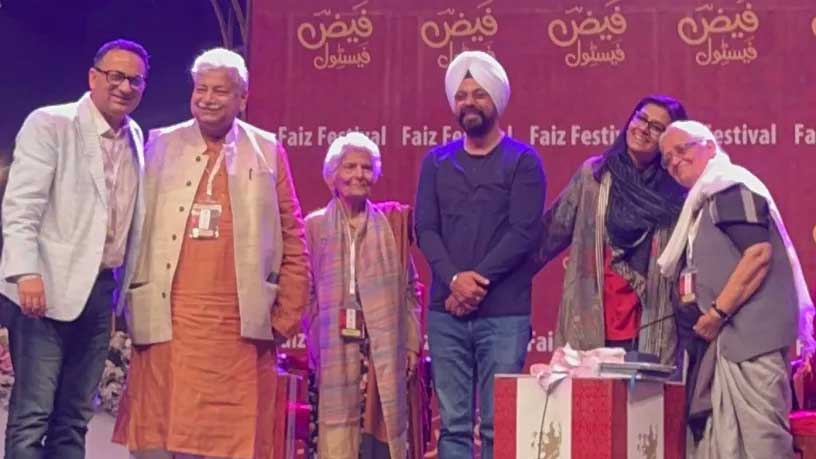“It’s the girls that give me hope,” says the celebrated poet and writer Zehra Nigah.
She leads a quiet life at her home in Karachi, without a mobile phone or email. Yet those who seek her are able to find her. Besides the school and college students who look to her for guidance, there are advertising companies looking for classy jingles. And there are organisers of literary festivals wanting to invite her.
These include Jashn-e-Rekhta, the three-day annual festival that celebrates Urdu — subtly countering the rightwing narrative that Urdu is a ‘Muslim’ language while Hindi is for ‘Hindus’.
When it started in 2015, Rekhta invited several prominent Pakistani poets and writers to participate. Its third edition in 2017 was the first time that there was no Pakistani participation in its sessions – due to the “prevailing atmosphere” in India, the organisers took “a considered decision” to not invite Pakistanis as “participants” but only as “guests”, reported Anita Joshua in the Telegraph, India.

“Some see in this an instance of self-censorship to avoid trouble of the sort that has recently beset Bollywood films starring Pakistani actors,” commented Joshua.
The only Pakistani who accepted the invitation was Kishwar Naheed, then 77, another iconic Pakistani poet, for whom being invited as a ‘guest’ meant that she would at least be able to recite at the ‘mushaira’, the poetry recital session addressed by several poets, as she told me later.
“Apa, are you not comfortable? Just enjoy it,” she quoted Sanjiv Saraf, the Rekhta founder. “I told him, I haven’t come all the way here to sit in the audience. If you won’t allow me to present my poetry, I’m going home”.
It was not until 2024 that Pakistani participants were back at Rekhta – at its annual Dubai edition started in January that year. They included Zehra Nigah, along with Dr Arfa Sayeda Zehra and Zarminae Ansari of The Joy of Urdu – incidentally, all three are among the hundreds of endorsers of the Southasia Peace Action Network or Sapan, that aims to uphold the narrative of peace, regionalism and dialogue.
Zehra Nigah also participated at Rekhta this year in Dubai, Feb 6-8, she told me when I ran into her at the departure lounge of Karachi’s Jinnah International Airport a few days later. That’s why she had not been at the Karachi Literature Festival the same weekend.
She was now going to the Faiz Festival in Lahore Feb 14-16, while I was headed to Islamabad for a discussion at the Black Hole.
Titled ‘Legacies of Hope: Peacebuilding in Southasia,’ my session aimed to commemorate our late comrade and fellow peacemonger Tapan Bose and put his work in context. Other speakers were Tapan’s longtime partner Rita Manchanda in Delhi, and the feminist activist Khushi Kabir in Dhaka. I would take a bus to Lahore for the Faiz Festival the following day where I would meet Zehra Apa again and hear her speak at a couple of sessions. More on that another time.
At Karachi airport, Zehra Apa tells me that she still misses my father, Dr M Sarwar, a family physician who passed away in 2009, a couple of months before his 80th birthday.
“Bohot achey admi they” (he was a very good man), she says.
I had sought Zehra Apa’s views on Pakistan’s first nation-wide student movement, the Democratic Students Federation, that my father led while in medical college in the 1950s. She was a teenager, in high school when she heard about the police opening fire on the unarmed DSF students demonstrating peacefully for their rights in Karachi on 8 January 1953. The firing killed 27 students and bystanders, and injured several.
There was no social media then, but news of the state violence spread fast and far and felt immediate and urgent to young people like Zehra Apa. “We felt it had happened in front of us, and it happened to us,” she said when I interviewed her for the documentary film we made about it.
Zehra Apa had written one of her first poems in response to that incident. I was particularly keen to include her because the role of women in the movement had been largely undocumented.
Documentary film ‘There Will Be More Caravans of Passion’ on Pakistan’s first nationwide student movement.
I had reached out to Zehra Apa some years earlier, for a report I made for Geo TV in 2004 on women in prison under the Hudood Ordinances, the draconian moral policing laws imposed by the military dictator Gen Ziaul Haq in the late 1970s. These laws made rape into a private offence that the survivor had to prove, and criminalised consensual adult sexual activity outside marriage.
Terms like ‘zina bil jabr’ (rape) and ‘zina’ (adultery) entered the lexicon. Punishments for ‘zina’ included stoning to death – a pre-Islamic punishment for which the burden of proof in Islam is so heavy that it can never be applied — and flogging.
While many journalists and writers had taken up these issues, in a country with a literacy rate as low as Pakistan’s (around 40% in the 1990s), the narrative advanced by the state-run Pakistan Television – the only television news channel then — is what informed the public and shaped public opinion.
Filmmaker Sabiha Sumar and researcher Khalid Nadvi made a powerful documentary exposing the hypocrisy of the ‘religious’ lobby ‘Who Will Cast the First Stone?’ (1988). The film, run on international channels and at film festivals, addressed the issue from an activist feminist perspective.
Zehra Apa’s powerful poem ‘Zina Ordinance’ which I had heard her recite at our house in Karachi before a small gathering some years ago, had also boldly tackled the issue. She was kind enough to record it for a report I did for Geo TV in 2004.
Zehra Nigah recites her poem on the Hudood Ordinance at the end of this special report on Geo TV, 2003.
Some of my other reports for Geo TV also explored issues that were broadcast for the first time by a television channel in Pakistan in its news programming. These issues, reported in Urdu, included reports on women in prison, forced marriage, the government’s well-meaning attempt to revive classical dance, and Sobho Gianchandani, a respected lawyer and friend of my father’s, who described himself as “a three-headed monster for the establishment” — a Sindhi, a Hindu, and a Communist.
At Karachi airport, I tell Zehra Apa about our peace initiative, the Southasia Peace Action Network that I co-founded in 2021. It draws on lessons learnt from the student movement my father led, like the importance of a minimum common agenda, a broad coalition beyond ideological, political or religious divides, involving the community in any fundraising efforts.
The Sapan Founding Charter calls for governments and peoples of the region to work towards letting people meet and participate in cross-border economic activities, to uphold human rights within their own borders before pointing fingers at others, and to cooperate and collaborate on all issues, ranging from climate change to cultural activities, to sport, education, and science.
Over 100 organisations and hundreds of individuals have endorsed the Founding Charter of this volunteer-run, inter-generational, cross-regional and cross-diasporic initiative since its launch in March 2021. Zehra Nigah is now among them.
“I don’t hold out too much hope,” she tells me. “But I would like to see India and Pakistan make peace in my lifetime.”
While there are rumours of back-channel dialogue taking place, currently, when one of these two nuclear-armed neighbours behaves reasonably, the other one throws a tantrum, and vice versa.
What will it take to bring them on the same page? What can we, the people, do to move the needle?
The floor is yours.
Beena Sarwar is a journalist and peace activist from Karachi and Lahore, based primarily in Boston for some years, where she teaches journalism at Emerson College.
This piece was written for Sapan News Network and is available for syndication with due credit to www.sapannews.com

